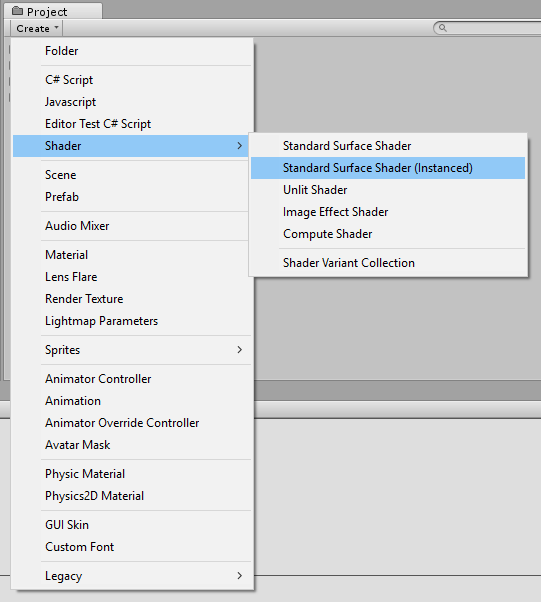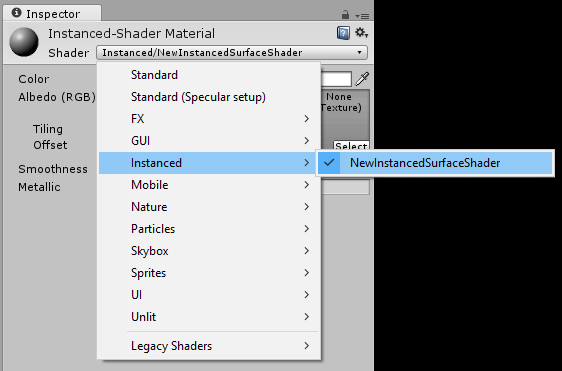- Unity User Manual (5.5)
- グラフィックス
- グラフィックスの概要
- 高度なレンダリング機能
- GPU インスタンシング
GPU インスタンシング
はじめに
You can use GPU instancing to draw many identical objects with only a few draw calls. There are some restrictions that you need to bear in mind:
- Your identical objects need to share the same Mesh and the same Material. You can, however, add per-instance data. See Adding per-instance data below for more information.
- MeshRenderer コンポーネントと Graphics.DrawMesh API がサポートされています。
- GPU インスタンシングは、以下のプラットホームで利用可能です。
- Windows: DX11 and DX12 with SM 4.0 and above / OpenGL 4.1 and above
- OS X and Linux: OpenGL 4.1 and above
- Mobile: OpenGL ES 3.0 and above / Metal
- PlayStation 4
- Xbox One
オブジェクトにインスタンシングを加える
A Standard Surface Shader that supports instancing is available in the Unity Editor. Add one to your project by selecting Shader > Standard Surface Shader (Instanced).

Apply this Shader to your GameObject’s Material. In your Material’s Inspector window, click the Shader drop-down, roll over the Instanced field, and choose your instanced Shader from the list:

インスタンスごとのデータを加える
Even though the instanced GameObjects are sharing the same Mesh and Material, you can set Shader properties on a per-object basis using the MaterialPropertyBlock API. In the example below, each GameObject is assigned a random color value using the _Color property:
MaterialPropertyBlock props = new MaterialPropertyBlock();
MeshRenderer renderer;
foreach (GameObject obj in objects)
{
float r = Random.Range(0.0f, 1.0f);
float g = Random.Range(0.0f, 1.0f);
float b = Random.Range(0.0f, 1.0f);
props.SetColor("_Color", new Color(r, g, b));
renderer = obj.GetComponent<MeshRenderer>();
renderer.SetPropertyBlock(props);
}
自分のシェーダーにインスタンシングを加える
The following example takes a simple unlit Shader and makes it capable of instancing:
Shader "SimplestInstancedShader"
{
Properties
{
_Color ("Color", Color) = (1, 1, 1, 1)
}
SubShader
{
Tags { "RenderType"="Opaque" }
LOD 100
Pass
{
CGPROGRAM
#pragma vertex vert
#pragma fragment frag
#pragma multi_compile_instancing
#include "UnityCG.cginc"
struct appdata
{
float4 vertex : POSITION;
UNITY_INSTANCE_ID
};
struct v2f
{
float4 vertex : SV_POSITION;
UNITY_INSTANCE_ID
};
UNITY_INSTANCING_CBUFFER_START (MyProperties)
UNITY_DEFINE_INSTANCED_PROP (float4, _Color)
UNITY_INSTANCING_CBUFFER_END
v2f vert (appdata v)
{
v2f o;
UNITY_SETUP_INSTANCE_ID (v);
UNITY_TRANSFER_INSTANCE_ID (v, o);
o.vertex = UnityObjectToClipPos (v.vertex);
return o;
}
fixed4 frag (v2f i) : SV_Target
{
UNITY_SETUP_INSTANCE_ID (i);
return UNITY_ACCESS_INSTANCED_PROP (_Color);
}
ENDCG
}
}
}
追加したコード
| Addition | 機能 |
|---|---|
| #pragma multi_compile_instancing |
multi_compile_instancing generates a Shader with two variants: one with built-in keyword INSTANCING_ON defined (allowing instancing), the other with nothing defined. This allows the Shader to fall back to a non-instanced version if instancing isn’t supported on the GPU. |
| UNITY_INSTANCE_ID | This is used in the vertex Shader input/output structure to define an instance ID. See SV_InstanceID for more information. |
| UNITY_INSTANCING_CBUFFER_START(name) / UNITY_INSTANCING_CBUFFER_END | インスタンスごとのプロパティーはすべて、予約された定数バッファで定義する必要があります。この一組になったマクロを使って、各インスタンスに固有化したいプロパティーをラップします。 |
| UNITY_DEFINE_INSTANCED_PROP(float4, color) | This defines a per-instance Shader property with a type and a name. In this example, the _color property is unique. |
| UNITY_SETUP_INSTANCE_ID(v); | This makes the instance ID accessible to Shader functions. It must be used at the very beginning of a vertex Shader, and is optional for fragment Shaders. |
| UNITY_TRANSFER_INSTANCE_ID(v, o); | This copies the instance ID from the input structure to the output structure in the vertex Shader. This is only necessary if you need to access per-instance data in the fragment Shader. |
| UNITY_ACCESS_INSTANCED_PROP(color) | This accesses a per-instance Shader property. It uses an instance ID to index into the instance data array. |
Note: As long as Material properties are instanced, Renderers can always be rendered instanced, even if you put different instanced properties into different Renderers. Normal (non-instanced) properties cannot be batched, so do not put them in the MaterialPropertyBlock. Instead, create different Materials for them.
A note regarding UnityObjectToClipPos
UnityObjectToClipPos(v.vertex) is always preferred where mul(UNITY_MATRIX_MVP,v.vertex) would otherwise be used. While you can continue to use UNITY_MATRIX_MVP as normal in instanced Shaders, UnityObjectToClipPos is the most efficient way of transforming vertex positions from object space into clip space.
In instanced Shaders, UNITY_MATRIX_MVP (among other built-in matrices) is transparently modified to include an extra matrix multiply. Specifically, it is expanded to mul(UNITY_MATRIX_VP, unity_ObjectToWorld). unity_ObjectToWorld is expanded to unity_ObjectToWorldArray[unity_InstanceID]).
UnityObjectToClipPos is optimized to perform two matrix-vector multiplications simultaneously, and is therefore more efficient than performing the multiplication manually, because the Shader compiler does not automatically perform this optimization.
Modifying multi-pass Shaders to work with instancing
For vertex and fragment Shaders, Unity needs to change the way vertex transformations are calculated in multi-pass scenarios (for example, in the ForwardAdd pass) to avoid z-fighting artifacts against the base/first passes due to floating point errors in matrix calculation. To do this, add #pragma force_concat_matrix to the Shader.
Specifically, the vertex transformation in the ForwardAdd pass is calculated by multiplying the M (model) matrix with the VP (view and projection) matrix instead of using a CPU-precomputed MVP matrix.
This is not necessary for surface Shaders, because the correct calculation is automatically substituted.
Batching priority
Static batching takes priority over instancing. If a GameObject is marked for static batching and is successfully batched, instancing is disabled even if its Renderer uses an instancing Shader. When this happens, a warning box appears in the Inspector suggesting that the Static Batching flag be unchecked in the Player Settings.
Instancing takes priority over dynamic batching. If Meshes can be instanced, dynamic batching is disabled.
注意
- Instanced draw calls appear in the Frame Debugger as Draw Mesh (instanced).
- When writing or modifying your own Shaders, don’t forget to instance shadows, too. For a surface Shader, use the
addshadowoption to force the generation of an instanced shadow pass. - You don’t have to define per-instance properties, but setting up an instance ID is mandatory, because world matrices need it to work correctly.
- フォワードレンダリングを使用するとき、複数のライトに影響されるオブジェクトは効果的にインスタンス化できません。基本パスのみでインスタンシングは効果的で、追加パスは効果がありません。
- ライトマップを使用したり、その他のライトやリフレクションプローブに影響されるオブジェクトはインスタンス化できません。
- If you have more than two passes for multi-pass Shaders, only the first passes can be instanced. This is because Unity forces the later passes to be rendered together for each object.
- D3D constant buffers have a maximum size of 64KB. For OpenGL, it’s usually 16KB. You will reach this limit if you try to define too many per-instance properties. The Shaders may fail to compile or, even worse, the Shader compiler might crash. To work around this, you have to balance between the size of the batch and the size of per-instance properties. Defining
UNITY_MAX_INSTANCE_COUNTwith an integer before including any .cginc file allows you to limit the maximum number of instances an instanced draw call can draw. This allows for more properties per instance in the instance constant buffer. You can achieve the same result when using a surface Shader with#pragma instancing_options maxcount:number. The default value of this max instance count is 500. For OpenGL, the actual value is one quarter of the value you specify, so 125 by default. - All the Shader macros used in the above example are defined in UnityInstancing.cginc. Find this file in [Unity folder]\Editor\Data\CGIncludes.